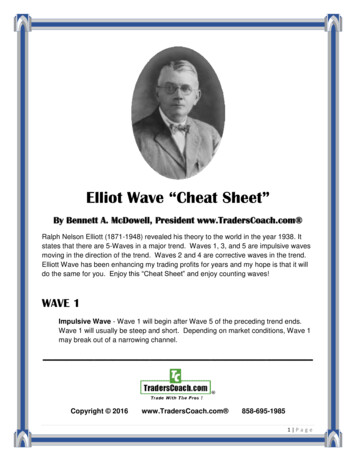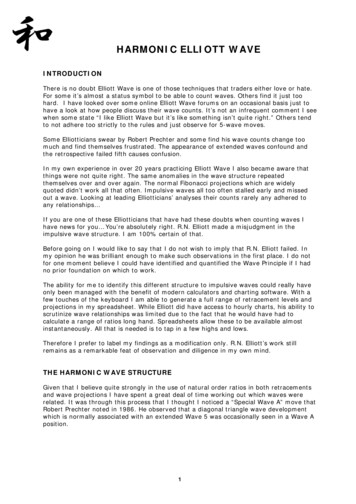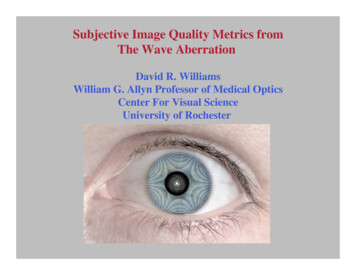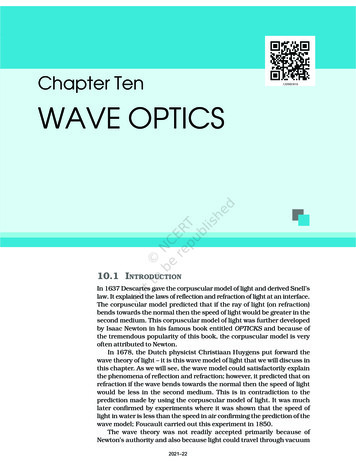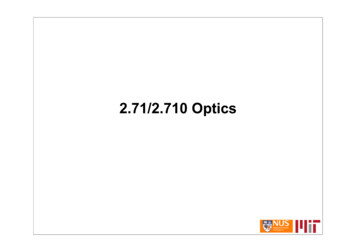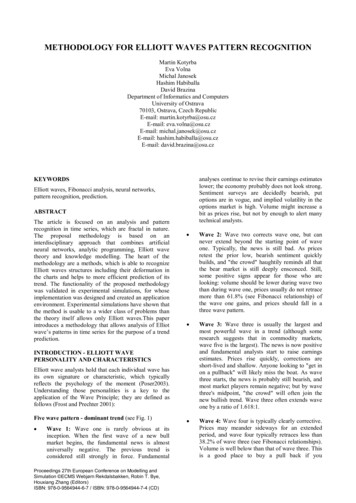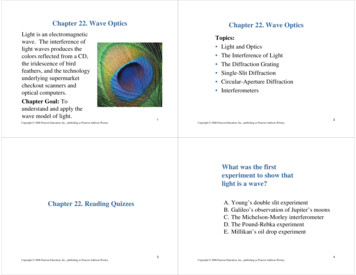
Transcription
Chapter 22. Wave OpticsLight is an electromagneticwave. The interference oflight waves produces thecolors reflected from a CD,the iridescence of birdfeathers, and the technologyunderlying supermarketcheckout scanners andoptical computers.Chapter Goal: Tounderstand and apply thewave model of light.Chapter 22. Wave OpticsTopics: Light and Optics The Interference of Light The Diffraction Grating Single-Slit Diffraction Circular-Aperture Diffraction Interferometers1Copyright 2008 Pearson Education, Inc., publishing as Pearson Addison-Wesley.2Copyright 2008 Pearson Education, Inc., publishing as Pearson Addison-Wesley.What was the firstexperiment to show thatlight is a wave?A. Young’s double slit experimentB. Galileo’s observation of Jupiter’s moonsC. The Michelson-Morley interferometerD. The Pound-Rebka experimentE. Millikan’s oil drop experimentChapter 22. Reading Quizzes3Copyright 2008 Pearson Education, Inc., publishing as Pearson Addison-Wesley.4Copyright 2008 Pearson Education, Inc., publishing as Pearson Addison-Wesley.
What was the firstexperiment to show thatlight is a wave?What is a diffraction grating?A. A device used to grate cheese and other materialsB. A musical instrument used to direct soundC. An opaque screen with a tiny circular apertureD. An opaque screen with many closely spaced slitsE. Diffraction gratings are not covered in Chapter 22.A. Young’s double slit experimentB. Galileo’s observation of Jupiter’s moonsC. The Michelson-Morley interferometerD. The Pound-Rebka experimentE. Millikan’s oil drop experiment5Copyright 2008 Pearson Education, Inc., publishing as Pearson Addison-Wesley.6Copyright 2008 Pearson Education, Inc., publishing as Pearson Addison-Wesley.When laser light shines on a screen afterpassing through two closely spaced slits,you seeWhat is a diffraction grating?A. A device used to grate cheese and other materialsB. A musical instrument used to direct soundC. An opaque screen with a tiny circular apertureD. An opaque screen with many closely spaced slitsE. Diffraction gratings are not covered in Chapter 22.A. a diffraction pattern.B. interference fringes.C. two dim, closely spaced points of light.D. constructive interference.7Copyright 2008 Pearson Education, Inc., publishing as Pearson Addison-Wesley.8Copyright 2008 Pearson Education, Inc., publishing as Pearson Addison-Wesley.
When laser light shines on a screen afterpassing through two closely spaced slits,you seeThis chapter discussed theA. acoustical interferometer.B. Michelson interferometer.C. Fabry-Perot interferometer.D. Both A and B.E. Both B and C.A. a diffraction pattern.B. interference fringes.C. two dim, closely spaced points of light.D. constructive interference.9Copyright 2008 Pearson Education, Inc., publishing as Pearson Addison-Wesley.The spreading of waves behindan aperture isThis chapter discussed theA. acoustical interferometer.B. Michelson interferometer.C. Fabry-Perot interferometer.D. Both A and B.E. Both B and C.11Copyright 2008 Pearson Education, Inc., publishing as Pearson Addison-Wesley.10Copyright 2008 Pearson Education, Inc., publishing as Pearson Addison-Wesley.A. more for longwavelengths, less for shortwavelengths.B. less for longwavelengths, more for shortwavelengths.C. the same for long andshort wavelengths.D. not discussed in this chapter.Copyright 2008 Pearson Education, Inc., publishing as Pearson Addison-Wesley.12
The spreading of waves behindan aperture isApertures for which diffractionis studied in this chapter areA. more for longwavelengths, less for shortwavelengths.B. less for longwavelengths, more for shortwavelengths.C. the same for long andshort wavelengths.D. not discussed in this chapter.A. a single slit.B. a circle.C. a square.D. both A and B.E. both A and C.13Copyright 2008 Pearson Education, Inc., publishing as Pearson Addison-Wesley.14Copyright 2008 Pearson Education, Inc., publishing as Pearson Addison-Wesley.Apertures for which diffractionis studied in this chapter areA. a single slit.B. a circle.C. a square.D. both A and B.E. both A and C.Chapter 22. Basic Content and Examples15Copyright 2008 Pearson Education, Inc., publishing as Pearson Addison-Wesley.16Copyright 2008 Pearson Education, Inc., publishing as Pearson Addison-Wesley.
Models of Light The wave model: under many circumstances, lightexhibits the same behavior as sound or water waves. Thestudy of light as a wave is called wave optics. The ray model: The properties of prisms, mirrors, andlenses are best understood in terms of light rays. The raymodel is the basis of ray optics. The photon model: In the quantum world, light behaveslike neither a wave nor a particle. Instead, light consists ofphotons that have both wave-like and particle-likeproperties. This is the quantum theory of light.17Copyright 2008 Pearson Education, Inc., publishing as Pearson Addison-Wesley.18Copyright 2008 Pearson Education, Inc., publishing as Pearson Addison-Wesley.19Copyright 2008 Pearson Education, Inc., publishing as Pearson Addison-Wesley.20Copyright 2008 Pearson Education, Inc., publishing as Pearson Addison-Wesley.
Analyzing Double-Slit InterferenceThe mth bright fringe emerging from the double slit is at ananglewhere θm is in radians, and we have used the small-angleapproximation. The y-position on the screen of the mthfringe iswhile dark fringes are located at positions21Copyright 2008 Pearson Education, Inc., publishing as Pearson Addison-Wesley.22Copyright 2008 Pearson Education, Inc., publishing as Pearson Addison-Wesley.EXAMPLE 22.2 Measuring the wavelength oflightEXAMPLE 22.2 Measuring the wavelength oflightQUESTION:23Copyright 2008 Pearson Education, Inc., publishing as Pearson Addison-Wesley.24Copyright 2008 Pearson Education, Inc., publishing as Pearson Addison-Wesley.
EXAMPLE 22.2 Measuring the wavelength oflightEXAMPLE 22.2 Measuring the wavelength oflight25Copyright 2008 Pearson Education, Inc., publishing as Pearson Addison-Wesley.26Copyright 2008 Pearson Education, Inc., publishing as Pearson Addison-Wesley.EXAMPLE 22.2 Measuring the wavelength oflightThe Diffraction GratingSuppose we were to replace the double slit with an opaquescreen that has N closely spaced slits. When illuminatedfrom one side, each of these slits becomes the sourceof a light wave that diffracts, or spreads out, behind the slit.Such a multi-slit device is called a diffraction grating.Bright fringes will occur at angles θm, such thatThe y-positions of these fringes will occur at27Copyright 2008 Pearson Education, Inc., publishing as Pearson Addison-Wesley.28Copyright 2008 Pearson Education, Inc., publishing as Pearson Addison-Wesley.
29Copyright 2008 Pearson Education, Inc., publishing as Pearson Addison-Wesley.30Copyright 2008 Pearson Education, Inc., publishing as Pearson Addison-Wesley.EXAMPLE 22.3 Measuring wavelengthsemitted by sodium atomsEXAMPLE 22.3 Measuring wavelengthsemitted by sodium atomsQUESTION:31Copyright 2008 Pearson Education, Inc., publishing as Pearson Addison-Wesley.32Copyright 2008 Pearson Education, Inc., publishing as Pearson Addison-Wesley.
EXAMPLE 22.3 Measuring wavelengthsemitted by sodium atomsEXAMPLE 22.3 Measuring wavelengthsemitted by sodium atoms33Copyright 2008 Pearson Education, Inc., publishing as Pearson Addison-Wesley.34Copyright 2008 Pearson Education, Inc., publishing as Pearson Addison-Wesley.35Copyright 2008 Pearson Education, Inc., publishing as Pearson Addison-Wesley.36Copyright 2008 Pearson Education, Inc., publishing as Pearson Addison-Wesley.
37Copyright 2008 Pearson Education, Inc., publishing as Pearson Addison-Wesley.38Copyright 2008 Pearson Education, Inc., publishing as Pearson Addison-Wesley.Single-Slit DiffractionConsider light of wavelength λ which passes through a slitof width a, and is then incident on a viewing screen adistance L beind the slit, where L a. The light patternwill consist of a central maximum flanked by a series ofweaker secondary maxima and dark fringes.The dark fringes occur at angles39Copyright 2008 Pearson Education, Inc., publishing as Pearson Addison-Wesley.40Copyright 2008 Pearson Education, Inc., publishing as Pearson Addison-Wesley.
EXAMPLE 22.4 Diffraction of a laser througha slitEXAMPLE 22.4 Diffraction of a laser througha slitQUESTION:4142Copyright 2008 Pearson Education, Inc., publishing as Pearson Addison-Wesley.Copyright 2008 Pearson Education, Inc., publishing as Pearson Addison-Wesley.EXAMPLE 22.4 Diffraction of a laser througha slitEXAMPLE 22.4 Diffraction of a laser througha slit43Copyright 2008 Pearson Education, Inc., publishing as Pearson Addison-Wesley.44Copyright 2008 Pearson Education, Inc., publishing as Pearson Addison-Wesley.
EXAMPLE 22.4 Diffraction of a laser througha slitCircular-Aperture DiffractionLight of wavelength λ passes through a circular aperture ofdiameter D, and is then incident on a viewing screen adistance L behind the aperture, L D. The diffractionpattern has a circular central maximum, surrounded by aseries of secondary bright fringes shaped like rings.The angle of the first minimum in the intensity isThe width of the central maximum on the screen is45Copyright 2008 Pearson Education, Inc., publishing as Pearson Addison-Wesley.46Copyright 2008 Pearson Education, Inc., publishing as Pearson Addison-Wesley.Tactics: Choosing a model of light47Copyright 2008 Pearson Education, Inc., publishing as Pearson Addison-Wesley.48Copyright 2008 Pearson Education, Inc., publishing as Pearson Addison-Wesley.
Measuring Indices of RefractionA Michelson interferometer can be used to measure indicesof refraction of gases. A cell of thickness d is inserted intoone arm of the cell. When the cell contains a vacuum, thenumber of wavelengths inside the cell isWhen the cell is filled with a specific gas, the number ofwavelengths spanning the distance d isFilling the cell has increased the lower path bywavelengths. By counting fringe shifts as the cell is filled,one can determine n.49Copyright 2008 Pearson Education, Inc., publishing as Pearson Addison-Wesley.50Copyright 2008 Pearson Education, Inc., publishing as Pearson Addison-Wesley.EXAMPLE 22.9 Measuring the index ofrefractionEXAMPLE 22.9 Measuring the index ofrefractionQUESTION:51Copyright 2008 Pearson Education, Inc., publishing as Pearson Addison-Wesley.52Copyright 2008 Pearson Education, Inc., publishing as Pearson Addison-Wesley.
EXAMPLE 22.9 Measuring the index ofrefractionEXAMPLE 22.9 Measuring the index ofrefraction53Copyright 2008 Pearson Education, Inc., publishing as Pearson Addison-Wesley.54Copyright 2008 Pearson Education, Inc., publishing as Pearson Addison-Wesley.General PrinciplesChapter 22. Summary Slides55Copyright 2008 Pearson Education, Inc., publishing as Pearson Addison-Wesley.56Copyright 2008 Pearson Education, Inc., publishing as Pearson Addison-Wesley.
General PrinciplesImportant Concepts5758Copyright 2008 Pearson Education, Inc., publishing as Pearson Addison-Wesley.Copyright 2008 Pearson Education, Inc., publishing as Pearson Addison-Wesley.ApplicationsApplications59Copyright 2008 Pearson Education, Inc., publishing as Pearson Addison-Wesley.60Copyright 2008 Pearson Education, Inc., publishing as Pearson Addison-Wesley.
ApplicationsApplications61Copyright 2008 Pearson Education, Inc., publishing as Pearson Addison-Wesley.62Copyright 2008 Pearson Education, Inc., publishing as Pearson Addison-Wesley.Suppose the viewing screen inthe figure is moved closer tothe double slit. What happensto the interference fringes?Chapter 22. Clicker QuestionsA. They fade out and disappear.B. They get out of focus.C. They get brighter and closer together.D. They get brighter and farther apart.E. They get brighter but otherwise do not change.63Copyright 2008 Pearson Education, Inc., publishing as Pearson Addison-Wesley.64Copyright 2008 Pearson Education, Inc., publishing as Pearson Addison-Wesley.
Light of wavelength λ1 illuminates adouble slit, and interference fringes areobserved on a screen behind the slits.When the wavelength is changed to λ2,the fringes get closer together. How largeis λ2 relative to λ1?Suppose the viewing screen inthe figure is moved closer tothe double slit. What happensto the interference fringes?A. λ2 is smaller than λ1.B. λ2 is larger than λ1.C. Cannot be determined from this information.A. They fade out and disappear.B. They get out of focus.C. They get brighter and closer together.D. They get brighter and farther apart.E. They get brighter but otherwise do not change.65Copyright 2008 Pearson Education, Inc., publishing as Pearson Addison-Wesley.66Copyright 2008 Pearson Education, Inc., publishing as Pearson Addison-Wesley.White light passes through a diffractiongrating and forms rainbow patterns on ascreen behind the grating. For eachrainbow,Light of wavelength λ1 illuminates adouble slit, and interference fringes areobserved on a screen behind the slits.When the wavelength is changed to λ2,the fringes get closer together. How largeis λ2 relative to λ1?A.the red side is farthest from the center of thescreen, the violet side is closest to the center.B.the red side is closest to the center of the screen,the violet side is farthest from the center.C.the red side is on the left, the violet side onthe right.D.the red side is on the right, the violet side onthe left.A. λ2 is smaller than λ1.B. λ2 is larger than λ1.C. Cannot be determined from this information.67Copyright 2008 Pearson Education, Inc., publishing as Pearson Addison-Wesley.68Copyright 2008 Pearson Education, Inc., publishing as Pearson Addison-Wesley.
The figure shows two single-slit diffractionpatterns. The distance between the slit and theviewing screen is the same in both cases. Whichof the following could be true?White light passes through a diffractiongrating and forms rainbow patterns on ascreen behind the grating. For eachrainbow,A. the red side is farthest from the center of thescreen, the violet side is closest to the center.B. the red side is closest to the center of the screen,the violet side is farthest from the center.C. the red side is on the left, the violet side onthe right.D. the red side is on the right, the violet side onthe left.A. The wavelengths are the same for both; a1 a2.B. The wavelengths are the same for both; a2 a1.C. The slits and the wavelengths are the same for both; p1 p2.D. The slits and the wavelengths are the same for both; p2 p1.69Copyright 2008 Pearson Education, Inc., publishing as Pearson Addison-Wesley.70Copyright 2008 Pearson Education, Inc., publishing as Pearson Addison-Wesley.The figure shows two single-slit diffractionpatterns. The distance between the slit and theviewing screen is the same in both cases. Whichof the following could be true?A Michelson interferometer using light ofwavelength λ has been adjusted to produce abright spot at the center of the interferencepattern. Mirror M1 is then moved distance λtoward the beam splitter while M2 is moveddistance λ away from the beam splitter. How manybright-dark-bright fringe shifts are seen?A. 4B. 3C. 2D. 1E. 0A. The wavelengths are the same for both; a1 a2.B. The wavelengths are the same for both; a2 a1.C. The slits and the wavelengths are the same for both; p1 p2.D. The slits and the wavelengths are the same for both; p2 p1.71Copyright 2008 Pearson Education, Inc., publishing as Pearson Addison-Wesley.72Copyright 2008 Pearson Education, Inc., publishing as Pearson Addison-Wesley.
A Michelson interferometer using light ofwavelength λ has been adjusted to produce abright spot at the center of the interferencepattern. Mirror M1 is then moved distance λtoward the beam splitter while M2 is moveddistance λ away from the beam splitter. How manybright-dark-bright fringe shifts are seen?A. 4B. 3C. 2D. 1E. 073Copyright 2008 Pearson Education, Inc., publishing as Pearson Addison-Wesley.
Models of Light The wave model: under many circumstances, light exhibits the same behavior as sound or water waves. The study of light as a wave is called wave optics. The ray model: The properties of prisms, mirrors, and lenses are best understood in terms of light rays. The ray model is the basis of ray optics.
